Gorilla Redemption
On March 18, we set out to do what we’ve been anticipating since the start of the trip: gorilla trekking. By 7AM, we were out the door of Buhoma Lodge, gaiters and all, and headed to the gorilla trekking headquarters at Bwindi.
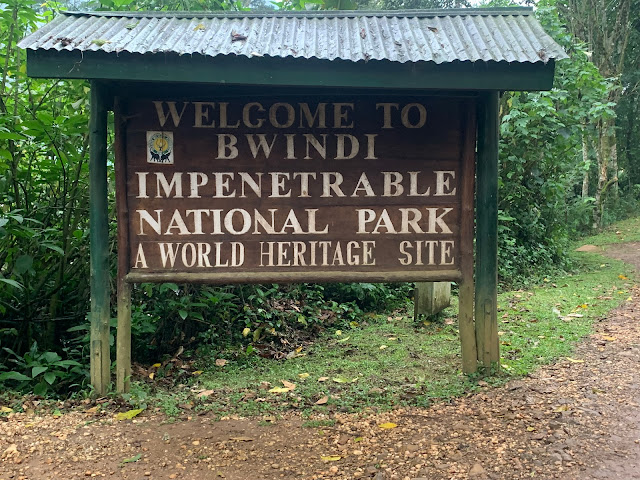 |
| The entrance to Bwindi. Our hotel was within the national park, so I took this photograph when we first drove to Buhoma. |
 |
| Geared up for the trek! |
Bwindi Impenetrable Forest is a UNESCO World Heritage site home to approximately half of the world’s mountain gorillas. Also known as the “Place of Darkness”, it lies in southwestern Uganda on the edge of the Rift Villey. “Bwindi” is derived from a word from the Runyakitara language and means “impenetrable”. The rainforest itself dates back over 25,000 years and contains almost 400 species of plants. The forest has 120 species of mammal which is more than any of Uganda’s other parks combined though sightings are typically less common due to the dense forest. The forest is one of the largest areas in East Africa which still has Afromontane lowland forest extending to well within the montane forest belt and is believed to be a remanent of a very large forest which once covered much of western Uganda, Rwanda, Burundi, and eastern Democratic Republic of the Congo. The park boundary is clearly delineated with planted trees and concrete pillars as markers along areas where rivers do not form the boundary. The clear boundary line has mostly stopped encroachment by the local communities although with the increasing population, agricultural encroachment will always remain a potential threat.
Upon entering headquarters, we had our temperatures taken and recorded, sanitized our hands, and then watched a dance performance by some of the women from the Ride 4 A Woman program. When their performance was complete, a UWA (Ugandan Wildlife Authority) official showed us a safety video and briefed us on proper behavior while gorilla trekking. From there, we were assigned our group: the Rushegura group.
Upon entering headquarters, we had our temperatures taken and recorded, sanitized our hands, and then watched a dance performance by some of the women from the Ride 4 A Woman program. When their performance was complete, a UWA (Ugandan Wildlife Authority) official showed us a safety video and briefed us on proper behavior while gorilla trekking. From there, we were assigned our group: the Rushegura group.
 |
| Our lead ranger, Peace, briefing us on the group. |
Mountain gorillas can be found in four national parks—Volcanoes National Park in Rwanda, Virunga National Park in Democratic Republic of the Congo, Mgahinga Gorilla National Park in Uganda, and Bwindi Impenetrable Forest in Uganda. Bwindi alone is divided into four main sectors—Rushaga, Nkuringo, Buhoma and Ruhija. The Rushaga and Buhoma sectors have the most gorilla groups and are popular for gorilla tracking. The success rates of seeing gorillas are over 90%, but treks can take a few hours to a full day of up to 8 hours or more of hiking in hot, high-altitude conditions. Typically, more than 70 people visit Bwindi on a given day but, on this day, there was only our group and one another—so two total groups were tracked.
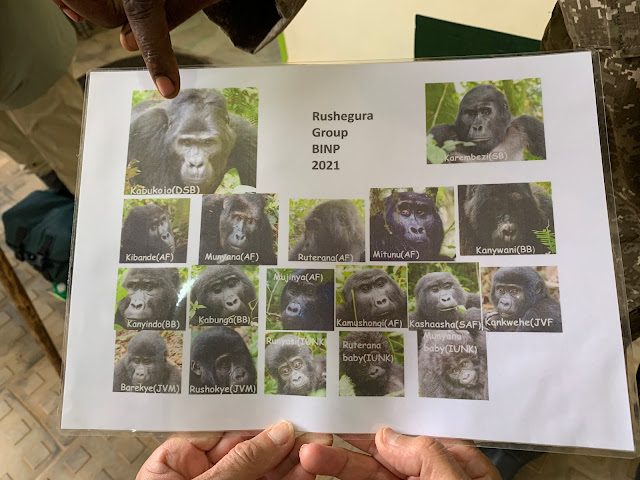 |
| Portraits of the gorilla group. |
 |
| The backside of the portrait card had specific information regarding the gorilla group. |
Our lead ranger, Peace, told us that this group is very large (19 individuals) and is one of the largest in Uganda. We were also informed that our group would be driven to the start of the trail—a 30-minute drive. Already, I was thinking it was going to be a long trek. I know people who trekked this same group just one week prior and they ended up having an 8-hour hiking day. I was just hoping we weren’t going to repeat that! We began our trek at 8:48AM, pulling up alongside a soccer field. We walked through a village, along tea and coffee plantations, and to the forest’s edge. That's when the real hiking began.
I consider myself fit—I try to exercise 6 days per week (thank you, Peloton) and I enjoy hiking and to say that this was probably the hardest hike I’ve done would be an understatement. I thought the Sarajevo Olympic bobsled and luge track was hard… This beat that 9-mile hike. Though we only ended up hiking approximately 3 miles (with an elevation gain of almost 500 feet), the terrain was difficult. Our lodge is situated at 4,889 feet and considering we drove 30 minutes to the start point, I assume we started at least at around 5,000 feet. I wish I would’ve known the exact altitude, because boy did I feel it. I typically can’t go above 7,000 feet due to altitude sickness, but I’ll feel it much lower than that (especially when I’m hiking and even more so with the Ugandan terrain). For a solid hour, we were trekking uphill with no breaks in incline.
Our porters were a huge help—not only did they carry our backpacks, they also literally shoved us on the rear and/or back and pulled us uphill. Even with the wooden walking sticks, it was often difficult to land your footing correctly and had I not had a porter (another woman named Peace), I probably would have fallen at least 5 times on that one-hour portion alone. Of course, we took water breaks and breaks to catch our breath in general, but the second I caught my breath and we resumed hiking, I was already out of breath again, my lungs threatening to expand out of my chest. When the porters noticed us starting to overheat, they pulled off ferns from nearby trees and fanned us with the leaves-- a thoughtful, much appreciated gesture. Just as I was thinking to myself “30 more minutes of this and I can’t do it anymore”, Peace told us that the gorillas were moving downhill. Great! Well, maybe? That meant we did a massive u-turn and headed back down the exact same way we had just hiked up… and that was slippery at times. I was almost tempted to just sit down and slide, but obviously that wouldn't have been the wisest decision so I did not do that (as much as I would have liked to during certain sections of the trail). As we got closer, we could see the gorillas high up in the trees. Finally, it was time to observe and photograph the gorillas. My hopes of getting good photographs were fading when I saw just how high up in the trees they were considering I only had my 70-200mm lens on me (I needed the f/2.8 for the forest lighting).
After observing some gorillas high in the trees, our gorilla group slowly started to move to the ground. This of course meant we had to move with them. We followed the gorillas down a small hill and into a clearing—finally. These were the photos I dreamt of getting in Rwanda but was disappointed when I trekked there because our group was in the thick forest canopy the entire time. With high overcast light and no rain here in Uganda, the conditions were perfect for photography. As the gorillas ascended another small hill, we followed them with all the gorillas still being fully visible in the clearing. We were surrounded by gorillas in every direction—babies, juveniles, females, and the large silverback.
Towards the end of our one hour with the gorillas (groups are only allowed one hour with the gorillas once the group is spotted), the entire gorilla family of 19 came walking across the path.
Peace decided to give us some extra time and waited for the entire gorilla family to continue crossing before we headed back down into the village—just 5 minutes away from where we had started our hike earlier in the day.
 |
| The view from where we ended on our trek. |
 |
| iPhone panorama of our last shooting location with the gorillas. |
 |
| When you're around the gorillas, you have to wear a mask to protect them. |
By the time we got into the vehicles to head back to the lodge, it was 12:09. We ate our picnic lunches that the lodge had packed for us back at the lodge (they pack you lunch since you never know how long you’ll be trekking for) and we spent the rest of the day relaxing, in total awe of the experience we just had.
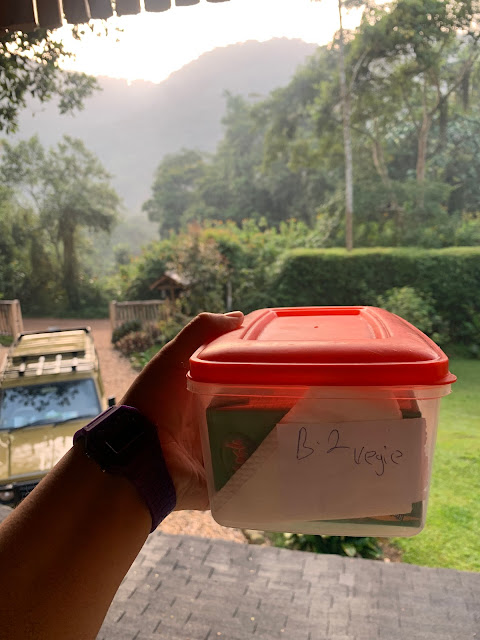 |
| Our packed lunches had a sandwich of our choice, mango juice, dried fruit, a muffin, and some other goodies. |
I then had another trek of 73 total stairs to get back to the room after lunch. That might not seem too bad, but after a long morning of gorilla trekking, that kills your legs. The L'hoest monkeys seemed to like the railing, though, and I photographed a mom with her baby for awhile.
In the late afternoon, I was going to head down to the main building to edit photos and use WiFi, but the second I was going to leave there was a massive downpour of rain and the loudest thunder I’ve ever heard. Perhaps the thunder echoed off the mountains, but the continuous boom was like a cannon going off right next to you—piercing the otherwise peaceful nature of the forest with the birds chittering and calling out to one another. When the thunderstorm passed, the mist began slowly covering the mountains. Filet mignon for dinner was the perfect ending to a great first day of gorilla trekking.
On March 19, we repeated the routine from the following day: breakfast at 7, out the lodge’s door at 7:30, sanitizer for our hands, temperature check, gorilla trekking briefing at 8am, and our gorilla trekking group assignment shortly after that. Today we had the Mubare group, a significantly smaller group than Rushegura.
The Mubare group consists of 9 gorillas and the silverback’s name translates to “prostitute”. Can you imagine naming a gorilla “prostitute”?! I got a kick out of that. The Mubare family was opened for tourism activities in 1993, making it the oldest habituated mountain gorilla family in the whole of Uganda. The family was first seen on the Mubare Hill which is how it got its name. We had the same lead ranger Peace today but different porters. My porter Catherine was the same age as me, 26, and she was a huge help when it came to crossing a river and squishing through the mud. If you saw today’s hike compared to yesterday’s, you would’ve thought we were in a completely different forest—there were vines with moss surrounding us in all directions, a river, and, to my pleasant surprise, it was mostly flat.
The gorilla group we had today was much closer than Rushegura and we hiked not even one hour before arriving to the gorilla group. Perhaps the most eventful part of the trek was crossing a river. At the beginning of the trek, we had used a bridge to get across but then Peace got a call from the trackers (who start following the gorillas at 6AM) saying that the gorillas had crossed the river. Rather than backtracking like we did the previous day, Peace found a different place for us to cross it. We initially were going to cross through the water, but she decided that the water was flowing too quickly so instead, she found an area of the river where the water was being diverted and taken to the village. Because of this, there was a concrete barrier that we could walk across but the challenging part came when it was time to climb back up the riverbank.
To climb back up the bank, Catherine was pushing me from behind and another porter was directly in front literally pulling me up. From there, it was probably a 5-minute walk to the Mubare group. With full sunshine and dense foliage, the photographic experience was drastically different than yesterday and way more challenging with the changing light and the fact that the gorillas were high in the trees. I think a large reason this group was more challenging, aside from the light, was the fact that the group was smaller so there were fewer opportunities to diversify shots. Regardless, it was still a great experience and Peace ended up giving us a full two hours with the gorillas – double the time you’d usually get. Below are some photos of the Mubare group.
When our time with the gorillas was up, we walked back to headquarters (we started our hike from headquarters today) which ended up being a 5-minute walk. From there, it was a 1-minute walk back to our lodge, where I spent the remainder of the afternoon editing photos and repacking for our next destination: chimpanzee trekking in Kibale.
On March 20, we rose before the crack of dawn. Breakfast was around 6AM, though I think we ended up eating closer to 5:30AM because everyone was ready. We were in the cars shortly after, and our flight from Kihihi to Kasese departed around 8:30AM (with no security checks or baggage weighed—all we had was a temperature screening).
The flight itself was around 20 minutes and as we landed, we saw elephants. When we landed, we walked straight from the dirt airstrip to the cars for our near 2-hour drive to Kibale National Forest (we took the scenic way). Driving along banana plantations and crater lakes, we had kids waving at us in all directions almost the entire time and we passed dozens of locals wearing beautifully patterned dresses walking home from Sunday church. We took a leg stretch about halfway through, stopping at the side of the round on a hill so we could look down into the lake below. We observed a bee eater for some time before hopping back into the cars for the remainder of the drive.
As we neared Primate Lodge, we came across baboons on the side of the road. At around 11:30, we finally reached the lodge. Below is a quick tour of some of the common areas--
 |
| The dining room at Primate Lodge. |
 |
| Close up of the dining room at Primate Lodge. I loved the stain glass windows! |
 |
| Close up of the stained glass windows, which were actually made from bottles. |
Now for the room tour...
After lunch, I went on a community walk. Unlike other African countries I’ve visited, I find the community walks in Uganda to be incredibly authentic, not touristy, and with no pressure to purchase any products. The locals are genuinely excited to share their culture with foreigners and in this case, the fee for the community walk directly benefits the community—for just $20, we had a 3-hour tour that I thoroughly enjoyed and the small fee goes towards community programs like the school, where no child pays for school supplies or tuition (they only need to purchase a uniform). I felt like I was supporting a great cause while having an amazing community experience and I'm so glad I decided to go. We walked from the tour headquarters across a soccer field, past the community water well, and down a narrow dirt path before arriving at our first stop: a local coffee and tea farmer.
During the coffee portion of the demonstration, 83-year-old Angelica walked us through the entire coffee process from picking the beans to the final cup of coffee and everything in between. Angelica showed us how to identify beans ready for picking and then put us to work—we went out into the field with small woven baskets and picked beans.
After the beans are picked, they’re laid out in the sun for 1-2 weeks depending on the weather where they dry out. To tell if the beans are ready to brew, you hold the dried coffee beans in your fist and shake them. If you can hear the bean shaking, they’re ready.
Angelica then got a wooden bowl and stick and began crushing the beans... I helped!
 |
| Crushing the dried beans. |
 |
| Crushing the beans was a good workout! |
 |
| The separation of the bean and the husk. |
She then shook them out of the shell, leaving only the beans, which were then roasted over the fire.
She made us a dark roast, so she cooked the beans until they were near black.
The beans were small when they were out of the shell, but when they were cooked, they expanded quite a bit. Angelica ground the coffee and sifted it several times before pouring us a cup.
I’m not one to drink a black cup of coffee, but this Ugandan coffee was so fresh that it didn’t need any milk or sugar. It was rich and beyond delicious! We also sampled some local tea, produced from herbs in Angelica’s garden.
Following the coffee demonstration, we went to the local medicine man (also referred to as a witch doctor and no, that term is not considered negative here). On the way, we got briefly distracted by chameleons on a bush. Our community guide, Mary, ended up putting four chameleons on one branch. She kept saying they were a family, but clearly, they were not as they were fighting.
We put them back to their respective branches and after photographing some locals, carried on to the medicine man.
He welcomed us into his practice by predicting how our journey has been so far. To do this, he threw sticks into a bucket of water right at the doorway. After telling us he believes we’ve had a good journey, he welcomed us inside.
He showed us how he collects local plants to treat various diseases and infections, the most treated being malaria especially during the rainy season. He showed us nature’s Viagra for men and women, an aloe vera mixture to treat wounds, an herbal drink to treat anemia, and even solutions for more personal problems like getting rid of a bad neighbor.
To get rid of a bad neighbor, he takes a chimpanzee skull taken from the forest (already dead, he doesn’t kill it), and sticks from a chimpanzee nest. He goes to the bad neighbor’s home when the neighbor isn’t there or when they are sleeping and when he reaches their doorway, he digs a small hole in the ground and buries the medicine. Then, when the ritual is done, the bad neighbor will become a good neighbor.
Unfortunately, at this point, time was running short as we had dinner arranged for 7PM (we were already way over the time limit with the community visit, but it was so interesting!) so we made a brief stop at a women’s co-op where they were weaving baskets under a jackfruit tree.
Of course, I bought another!
By the time we retraced our steps, walking past the medicine man, chameleon bush, coffee farm, the well, and the soccer field, it was already 7PM… dinner time. Thankfully, the town isn’t super far away so we weren’t that late to dinner—pumpkin soup and steak.
As always, wifi in Africa can be spotty but I'll be keeping a detailed account of my experiences in Uganda and Kenya and uploading blogs with photos when I can! Stay tuned for more, and follow along with my Instagram @elissatitle for more pics.


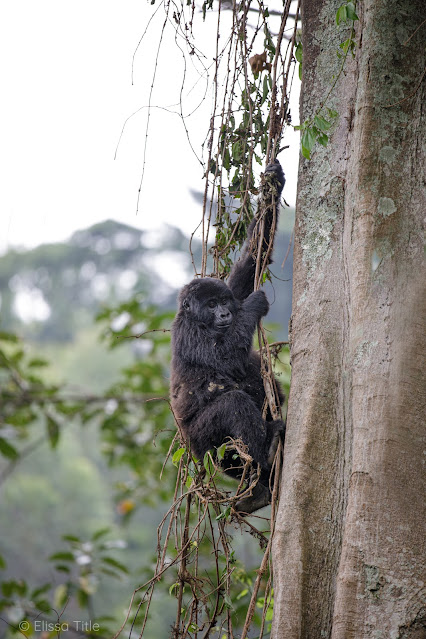





















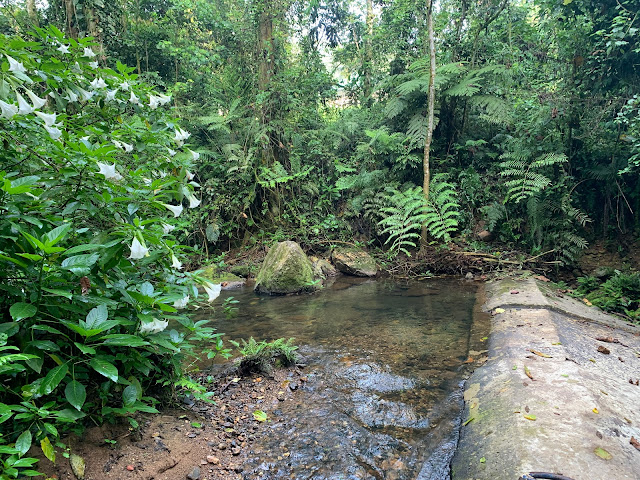











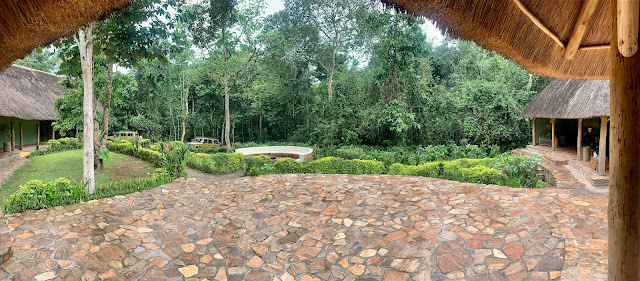
























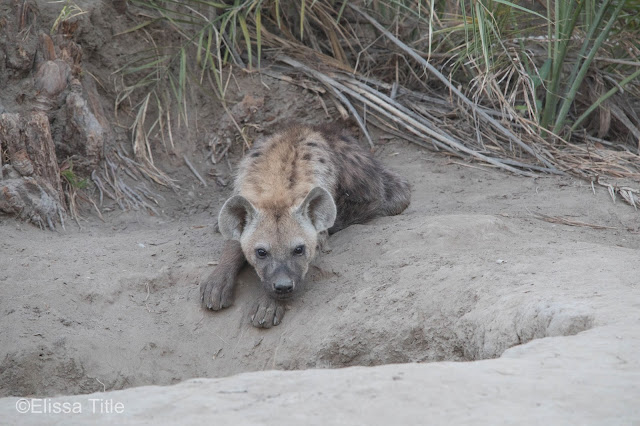





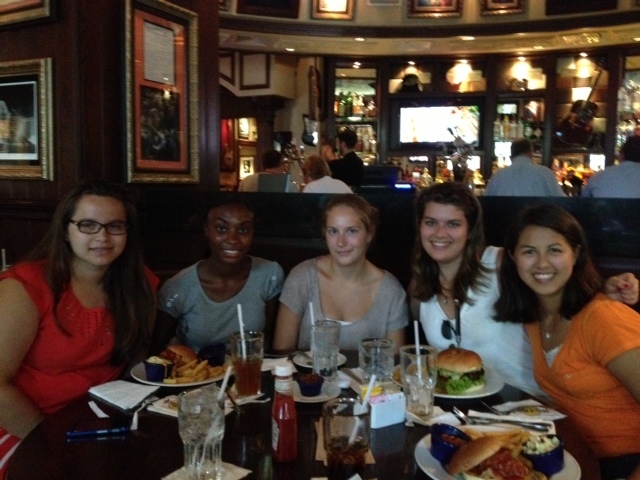


Comments
Post a Comment